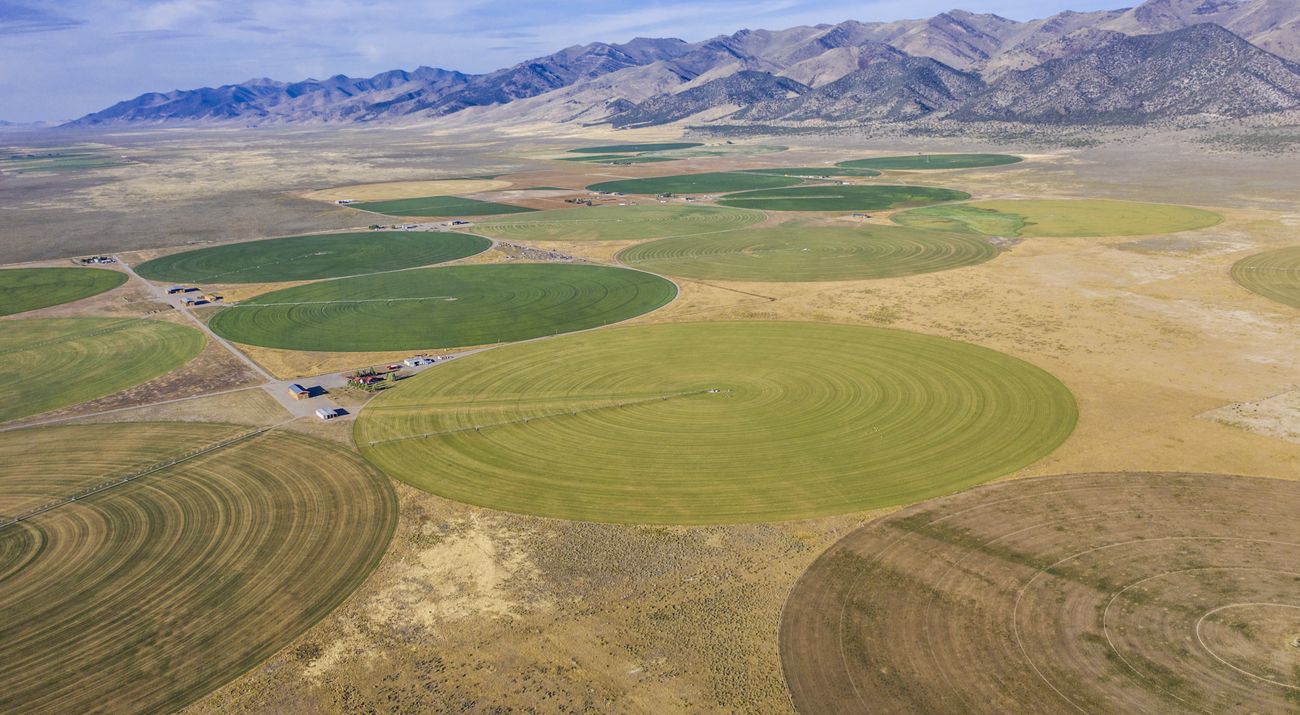New paper highlights benefits of coupling agrivoltaics with retiring groundwater rights in Nevada
Deploying agrivoltaics concurrently with groundwater rights retirement may have positive economic and ecological outcomes
Media Contacts
-
Lena Rueck
The Nature Conservancy
Phone: 801-822-7990
Email: lena.rueck@tnc.org
With proper planning and some additional infrastructure, agrivoltaics—where agriculture and solar energy production occur together on the same land—and water rights retirement could be beneficial to simultaneously implement in arid areas like Nevada. This is according to a new paper published by The Nature Conservancy (TNC) in partnership with Eureka Conservation District and Eureka County in the Journal of the American Water Resources Association. The paper shares a study in Diamond Valley, Nevada, in which the partners explored the viability and socioeconomic benefits and tradeoffs of retiring groundwater rights while at the same time implementing agrivoltaics.
In 2015, Diamond Valley was designated as a Critical Management Area, and the community developed and implemented a groundwater management plan (GMP). The goals of the plan include stabilizing groundwater levels, preserving the economy and culture of Diamond Valley and maximizing viable uses of private land. Due to planned reductions in irrigated water use, some farmland will be coming out of production. As the GMP is implemented, stakeholders are figuring out how the economy and culture of Diamond Valley can continue to thrive with less water.
Retiring groundwater rights is something that was implemented in Nevada as a tool for reducing groundwater overuse through the Nevada Water Conservation and Infrastructure Initiative (NWCII). Now, two bills, AB 104 and SB 36, are being considered by the legislature for a longer-term program. Several water right holders in Diamond Valley are retiring their groundwater rights under the NWCII, “but,” said Laurel Saito, Nevada water strategy director for The Nature Conservancy, “it is important to think about what will be done with the land when irrigation is removed.”
A possible strategy to achieve multiple goals in the GMP is to retire private property groundwater rights while at the same time transitioning all or portions of formerly irrigated agricultural lands to photovoltaic solar farms.
“These are two of the biggest issues in the West right now: the renewable energy buildout and the overall water scarcity, groundwater in particular, for Nevada,” said Peter Gower, The Nature Conservancy’s Western U.S. and Canada Division climate and renewable energy director. “This study explores a possible solution that could address both while still allowing communities to thrive.”
“Water rights retirement would assist in more quickly meeting the ultimate objective of the Diamond Valley Groundwater Management Plan of stabilizing drawdown of the water table,” said Jake Tibbitts, natural resources manager for Eureka County. “Agrivoltaics is a land use that could be a natural fit and an incentive for the valley to transition to. It could assist in meeting alternative energy goals while including an agricultural component and providing another value-added economic opportunity for landowners.”
The study consisted of two phases: 1) conducting a situation assessment to get substantive input from affected stakeholders and 2) evaluating technical aspects of retiring groundwater rights while transitioning agricultural land to non-irrigated agrivoltaics.
Some key findings from the study:
Groundwater rights retirement: It is essential to establish a fair and robust system to retire groundwater rights that conserves water. Due to limited available data, complex analysis using multiple approaches will be required to come up with valuation for groundwater rights in Diamond Valley.
Solar development and grid interconnection potential: Diamond Valley receives enough sunshine that utility-scale solar is both economically and technologically feasible. However, transmission capacity is a limiting factor due to existing infrastructure and competing projects, even with the proposed Greenlink North powerline. The terms of a solar lease between a landowner and developer are important for protecting landowners from financial risks.
Agrivoltaics in Diamond Valley: Agrivoltaics can provide diversification of income for farmers in Diamond Valley. Most soil types currently under irrigation in Diamond Valley are well-suited for the establishment of vegetation that can subsist and persist on precipitation alone.
Stay up-to-date with conservation near you.
Sign up for monthly emails to receive the latest stories and opportunities to get involved!
The Nature Conservancy is a global conservation organization dedicated to conserving the lands and waters on which all life depends. Guided by science, we create innovative, on-the-ground solutions to our world’s toughest challenges so that nature and people can thrive together. We are tackling climate change, conserving lands, waters and oceans at an unprecedented scale, providing food and water sustainably and helping make cities more resilient. The Nature Conservancy is working to make a lasting difference around the world in 81 countries and territories (40 by direct conservation impact and 41 through partners) through a collaborative approach that engages local communities, governments, the private sector, and other partners. To learn more, visit nature.org or follow @nature_press on X.
